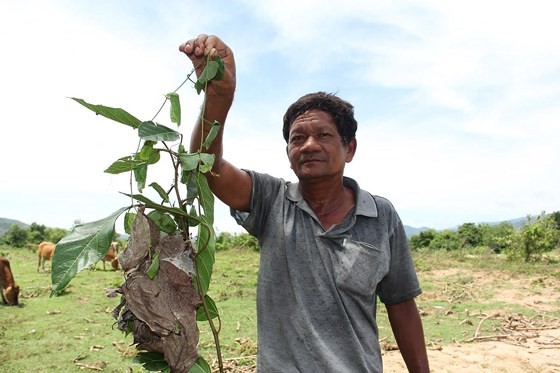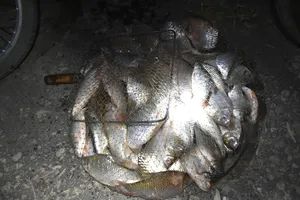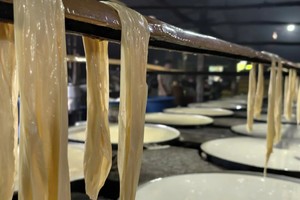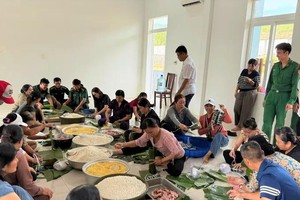
Ant-seeking journey
As we were nearing the Me Linh town junction, a group armed with machetes and sacks rushed through on their motorbikes. They explained that they were on the hunt for weaver ants, but before we could ask for the purpose of that, they quickly rushed off.
We had been recommended to Mr. Nay Mo, a local of Ngom village, Chu Drang commune, and an expert weaver ant seeker, who was then letting us come along on his hunting trip.
He began to open up to us on the way, saying how he started catching and eating weaver ants 30 years ago. “The best time to catch these things are from December to March as they will be carrying eggs, which enhance the taste”, he said.
We stopped at the edge of an orchard right beside Uar stream, where Mr. Mo pointed out a treeline beyond the stream as our destination and told us to follow him on foot. We did not venture far before he suddenly exclaimed: “There’s a nest”, and before we knew it he was halfway up a medium sized tree where there was a black lump hanging. He proceeded to chop down the whole twig with the ant nest still stuck on it, and quickly dumped everything into a sack.
After a short break, we continued to pass through more orchards in search of weaver ant nests. There were multiple times when the ants crawled out of their hidings and bit Mr. Mo all over, but he just shrugged it off. “You’ll get used to their bitings once you’ve spent dozens of years catching them”, he said.
Weaver ant hunters are often willing to travel deep into orchards far away from residential area in search of more tasty ants, the ones that are not exposed to rubbish.
The one thing that Jrai people absolutely avoid is destroying trees during their hunts, as they know it would drive the ants away. The sentiment has been passed down from generations within the community.
Delicacy of the barren land
To force weaver ants out of their previously harvested nests, people normally put the whole nest into a heating pot. The heat will also put down the ants once they got out, and people can then pile them up easily.
People usually use freshly caught weaver ants as seasoning for their home-cooked dishes. “Their rich and sour taste is excellent when you want to get rid of the smell of fish in your tomato soup”, said Mr. Mo.
But it is the dried ants mixed with chili salt that makes for Krong Pa’s delicacy. Large quantity of weaver ants are delivered to shredded dried beef manufacturers, who will then fry them up with chili salt which makes for a tasty spice to accompany the dried beef.
There are about 20 businesses selling dried beef along with weaver ant salt within Krong Pa District. Prices can go up to VND500,000 (about US$21.5) per kilogram with a free pack of savory weaver ant salt.
According to Ms. Pham Thi Anh Nguyet, the owner of one such business, she can acquire as much as 70kg of ants per day at VND50,000-70,000 (US$2-$3) a kilogram during peak season. “Each 4kg of fresh ant can make for 1kg of ingredient when dried up”, she added.
























